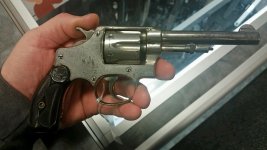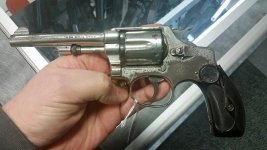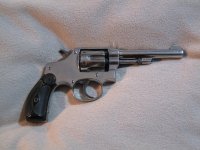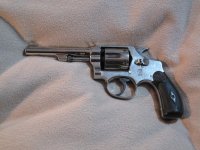Generally, I agree with the rational behind all that has been said in this thread: a refinished gun has 0% original finish, which is a consideration for pricing, and most of the cost of a refinish will be lost; it generally doesn't add much, if anything, to the value of the gun.
I'd like to add a comment about heirloom revolvers. Generally, a majority of the guns that show up for sale in all the venues are estate guns, in which the heirs have no interest, for a variety of reasons. Usually the heirs don't care about guns, and would much rather have the money. (This is often true for business's; the heirs want to spend their time doing something else.) In the case of a heir who is not a serious gun person, the condition of a piece might sway their interest one way or another.
Having said that, I do have a 4" 32-20 target revolver that showed a lot of wear when I acquired it. The following two pictures show the condition on arrival.
This is a rare gun, but in poor condition. There is a lot of wear all around on the metal surfaces, and the grips have lost almost all their checkering.
Additionally, there is a not-too-bad bulge in the barrel just under the front sight base. The best part of the gun is that it letters as a 4" target!
I sent the gun to Dave Chicoine for a refinish, or restoration, and he did an outstanding job with it. I sent the grips to Keith Brown, and his work revealed all the wonderful circassian walnut straight-line grain. The next two pictures show the gun after all the work.
In this case, I think the value of the gun has been increased, but only a well-attended auction will deal with that issue. I know that I like it a whole lot more!
There are three issues worth noting. There is a nick in the top edge of the front half of the sideplate, and it cross's into the bottom edge of the cylinder window in the frame. I elected to leave that undistrubed, so as not to remove any more metal than necessary. Secondly, Dave and I both felt that the external surface of the bulge in the barrel would be best eliminated by lightly filing around the bulge. This, of course, took off the top surface of the most forward part of the caliber roll marking on the right side of the barrel. It's still readable in that small region, but appears as a lighter strike. Finally, he blued the screw-on extractor rod knob. I removed the bluing, and its now back to its original case coloring.
Regards, Mike Priwer









